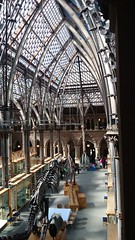I was lucky enough to get a set of Here Active Listening buds from DopplerLabs.
The buds are a set of small digital signal processors (DSP) that sit in the ears. They are about the size an in-ear bud and sit snugly in the ear canal (with changeable rubber seats) that are paired by Bluetooth to a phone app. Whilst the DSP buds do the work, the app provides the controls
The first screen displays volume, the second an equalizer and the third has a variety of filters, from transport to an office to Coachella (or festival mode). When the buds are connected, making a change on the phone becomes reflected into the buds in fairly short order, depending on the type of change.
At the moment, it appears to be marketed as a way of listening to music, either at a small gig or a large one like Coachella. Not having a festival that I was attending, I thought they’d be fun for some experiments in altering aural perception walking around a city.
As the first one, I popped the buds in whilst watching a film and doing other things. The application worked very well but the experience of updating the aural version of the room is very disorientating. Signal connection in the particular part of Oxford that I’m in is not always that good but the buds reconnected on their own when needed. Being able to alter the background sounds using the filters and altering the decibels is an unsettling experience but one that I could get used to with more time.
It does raise some questions about the value of altering sound for users and the Human Computer Interaction for augmented aural reality. At the moment, augmented and virtual reality is being targeted at visual stimuli but sound is not as popular.
Using the festival is a good place to try this out but I am more interested in social experiences in museums or galleries and the use of sound there.
 I thought it might be fun to go the Oxford University Museum of Natural History as it often has various exhibitions and dinosaurs. It also has a place in the history of science.
I thought it might be fun to go the Oxford University Museum of Natural History as it often has various exhibitions and dinosaurs. It also has a place in the history of science.
The bud connections had a major problem with the building. As you can see from the images, the Victorians built their museums to last with an iron frame. Iron frames and bluetooth do not mix and that part of Oxford has terrible reception due to tall buildings. For the connection that I could get, the app provided a slightly surreal way of filtering out parts of the background and focussing on a particular set of sounds. What I was hoping for was to see if the suggested DJ sound filter could be used to focus attention on one part or one song. Could it be validly used for groups in a museum? I haven’t found the answer but I can see the application. In all, it was fun though to use it whilst in the area.
The major issue for me wasn’t in the application but the connection in a set of old buildings. I don’t think that there is much Doppler might do for that but Here shows some possibilities for exploration. A new popped into my head whilst writing this so I’m excited. A beautifully designed set of hardware and software, there is a real sense of craftmanship to this. I recently backed Ossic on Kickstarter and am really excited about the possibilities of sound.
No Comments